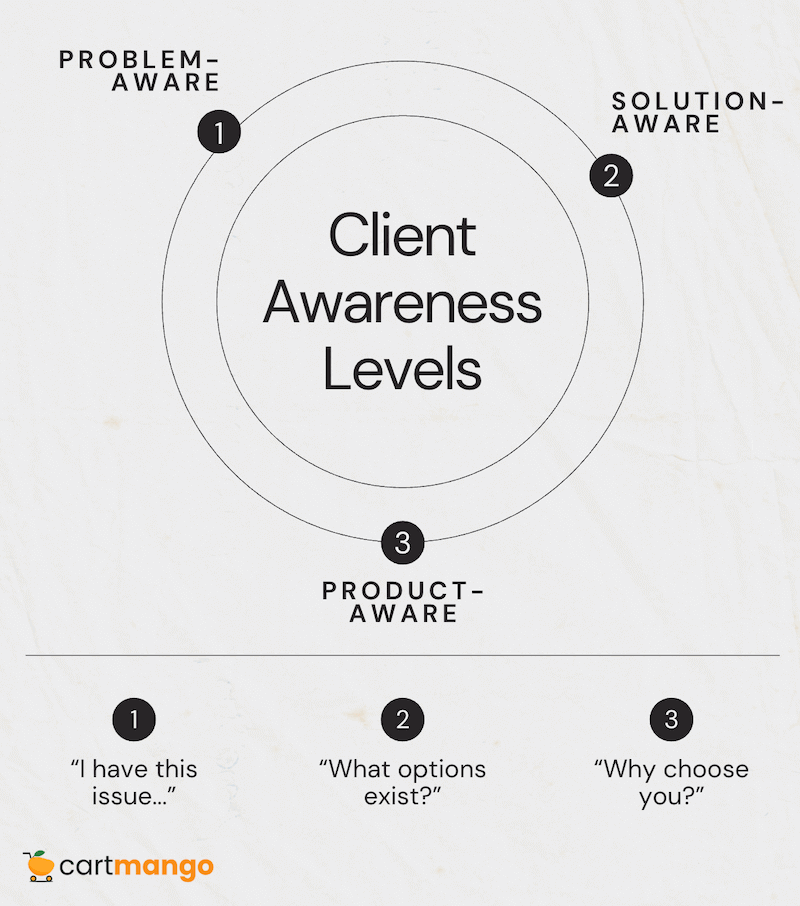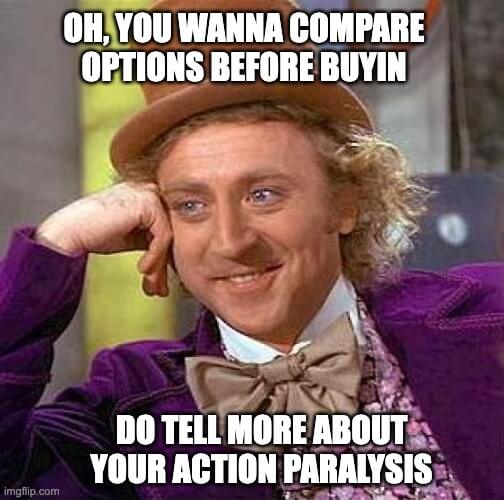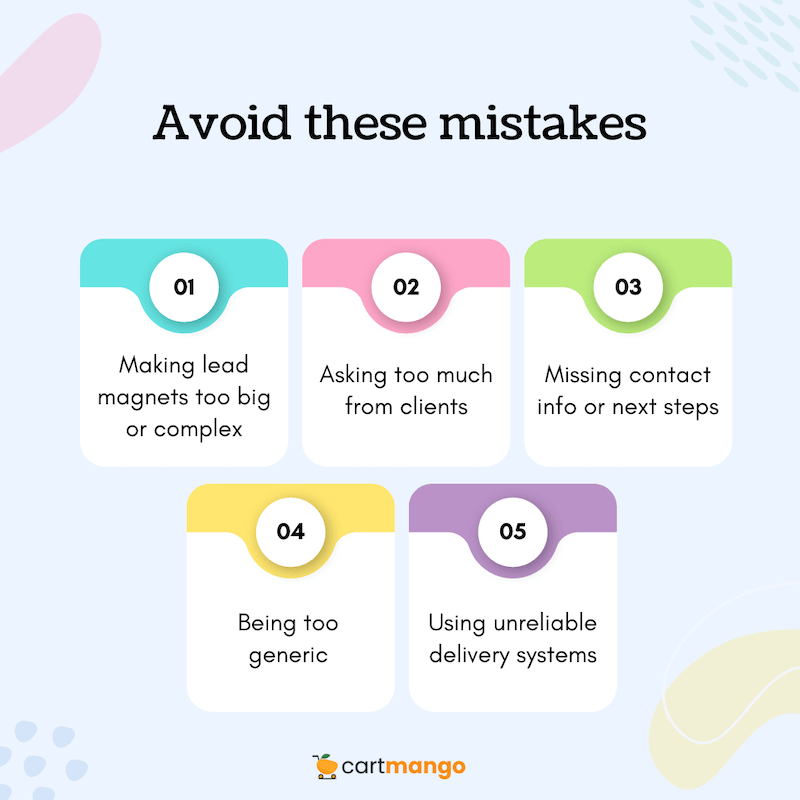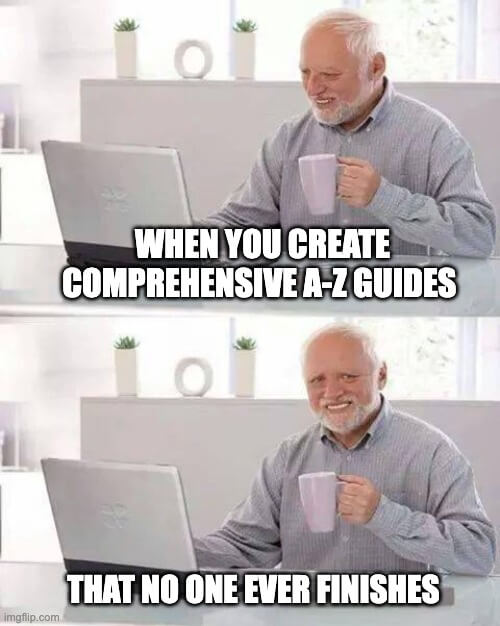To jump straight to the 2-hour lead magnet method, go here.
–
Instead of starting this guide with the same-old “what is a lead magnet and why do you need one” cliché…
Let’s actually give you what you want. Right now.
Lead Magnets for The Top 10 Coaching Niches
| Coaching Niche | Quick Win Lead Magnet | Assessment Lead Magnet | Template Lead Magnet | Challenge Lead Magnet |
|---|---|---|---|---|
Life | Values Finder Worksheet | Goal Clarity Quiz | Daily Win Tracker | 3-Day Confidence Challenge |
Business | Client Attraction Checklist | Business Readiness Test | Pricing Calculator | 5-Day Profit Booster |
Fitness | Workout Plan Template | Fitness Level Assessment | Nutrition Tracker | 7-Day Movement Challenge |
Career | Resume Checklist | Skills Assessment | Salary Script | Interview Prep Challenge |
Relationship | Communication Guide | Relationship Style Quiz | Conflict Resolution Template | Connection Challenge |
Executive | Decision Framework | Leadership Blind Spots | Team Communication Template | Productivity Sprint |
Financial | Budget Template | Financial Health Quiz | Debt Payoff Calculator | Savings Challenge |
Mindset | Morning Ritual Guide | Limiting Beliefs Identifier | Productivity Tracker | Mindset Reset Challenge |
Health & Wellness | Meal Planning Guide | Wellness Balance Quiz | Progress Tracker | Sleep Improvement Challenge |
Sales | Objection Response Guide | Sales Strengths Assessment | Client Follow-Up Template | Prospecting Challenge |
Want to grow your coaching business? Pick any lead magnet idea from the chart above that matches your coaching niche. They’re proven formats that work for specific coaching specialties.
I’ve organized them by how quickly you can create them and what results they deliver. Start with one that feels comfortable to make, then test how your audience responds.
How to Use This Chart
Look at your coaching niche first, then decide what type of lead magnet fits your skills.
- Quick win lead magnets take the least time to create but still provide value.
- Assessment lead magnets often convert highest because they provide personalized insights.
- Template lead magnets work well for practical, action-oriented coaches.
- Challenge lead magnets build deeper relationships but require more follow-up.

Match the format to both your coaching style and your ideal client’s preferences.
–
Tailor Lead Magnets to Client Awareness Levels
Most coaches create one-size-fits-all lead magnets. Instead, match your approach to where prospects are in their journey:

| Awareness Stage | Client Mindset | Best Lead Magnet Type | Example | Follow-Up Focus |
|---|---|---|---|---|
Problem-Aware | “I have this issue…” | Diagnostic Tools | Self-Assessment Quiz | Validate their problem |
Solution-Aware | “What options exist?” | Comparison Guides | Methods Comparison | Position your approach |
Product-Aware | “Why choose you?” | Service Samples | Mini-Session | Show your unique value |
Someone who knows they have a problem needs different information than someone ready to hire a coach. Problem-aware clients need help understanding their situation better.
Solution-aware clients want to compare options before deciding. Product-aware clients want to see what makes you different from other coaches.
Matching your lead magnet to their awareness level makes your offer feel perfectly timed. This approach works better than generic lead magnets that try to speak to everyone at once.
Problem-Aware Lead Magnet Example
For a business coach working with problem-aware prospects who know they’re struggling with time management:
Create a “Productivity Leaks Assessment” that helps them identify exactly where their time is going. This diagnostic tool confirms what they suspected (they have a problem) and puts a name to their specific challenges.
The follow-up should validate their results and show them they’re not alone. Only then should you introduce potential solutions.
Solution-Aware Lead Magnet Example

For the same business coach working with solution-aware prospects:
Create a “Time Management Systems Comparison Guide” that breaks down different productivity approaches. This helps prospects who already know they need help but aren’t sure which approach is right for them.
Your follow-up should highlight the pros and cons of each method while positioning your coaching approach as the best fit for specific types of clients.
Product-Aware Lead Magnet Example
For prospects who are evaluating different coaches:
Offer a “15-Minute Productivity Breakthrough Session” where they experience your coaching firsthand. These prospects are ready to work with someone; they just need to know it should be you.
Your follow-up should emphasize your unique approach and results, with clear next steps to become a client.
–
Lead Magnet Creation Time vs. Effectiveness
| Lead Magnet Type | Creation Time | Tech Skills | Conversion Rate | Best For |
|---|---|---|---|---|
PDF Cheat Sheet | 1-2 hours | Low | Medium | Quick wins, simple tips |
Self-Assessment | 2-4 hours | Medium | High | Engagement, personalization |
Template | 1-3 hours | Low | Medium-High | Practical application |
Mini-Challenge | 3-5 hours | Medium | High | Relationship building |
Video Training | 2-3 hours | Medium | Medium | Showing personality |
Let’s be honest about what matters: how long will it take you to make a lead magnet, and will it actually work?
The chart above breaks this down for the most popular formats.
Self-assessments and mini-challenges convert best but take longer to create. One-page cheat sheets and templates can be made quickly with basic skills.
Choose based on what you can realistically create with your available time and skills. Better to have a simple lead magnet that exists than a fancy one that never gets finished.
–
Creation Tips for Each Format
PDF Cheat Sheets
Start with a simple Word or Google Doc. Add section headers, bullet points, and 1-2 graphics. Convert to PDF when done.
Don’t worry about perfect design – clean, readable formatting matters more than fancy graphics. Use Canva templates if you want something more polished.
Self-Assessments
Start with 5-7 multiple-choice questions. Create scoring ranges that lead to 3-4 possible outcomes. Each outcome should include specific next steps.
Google Forms is the simplest tech option, though specialized quiz tools like TypeForm offer more features. Always test your assessment multiple times before launching.
Templates
Focus on one specific process your clients struggle with. Include clear instructions and examples of completed sections.
Make sure the template is actually usable without extensive training. Overly complex templates won’t get used, no matter how comprehensive they are.
Mini-Challenges
Break your challenge into 3-5 days maximum. Each day’s task should take no more than 15 minutes and provide a clear win.
Create an email for each day that includes instructions, examples, and encouragement. Schedule these to send automatically using your email service provider.
Video Training
Script your main points before recording. Keep videos under 20 minutes – 10-15 minutes is ideal.
You don’t need fancy equipment – a smartphone on a stable surface with good lighting works fine.
Clear audio matters more than perfect video quality.
–
What Is a Lead Magnet and Why Coaches Need One
A lead magnet is a free item you give away to get someone’s email address.
For coaches, this helps you:
- Get potential clients’ contact info
- Build trust
- Show your expertise
- Start conversations that can lead to paid coaching
The average ROI for email marketing across industries ranges from $36 to $40 for every dollar spent (source), making your email list your most valuable asset as a coach.
Why bother with lead magnets when you could just ask for emails?
Because nobody wants more random emails in their inbox. People need a good reason to share their contact information.
Your lead magnet turns strangers into potential clients by giving them a sample of how you can help. This first step builds the relationship that can eventually lead to paid coaching.
The Lead Magnet Mindset Shift
Stop thinking of lead magnets as “free stuff” and start thinking of them as “micro-coaching.” Each lead magnet should deliver a small but real transformation.
The best lead magnets demonstrate your unique coaching approach while solving an immediate problem. They should make prospects think, “If the free stuff is this helpful, imagine what the paid coaching must be like.”
Why Email Lists Beat Social Media
Social media algorithms change constantly, potentially cutting off access to your audience overnight. Your email list belongs to you alone.
Email also creates a direct, personal connection that social media can’t match. When someone reads your email, you have their full attention without competing posts or notifications.
Building an email list through lead magnets gives you a consistent way to nurture relationships over time. This patience pays off in higher conversion rates and more committed clients.
–
5 Lead Magnets Coaches Can Create Quickly
1/ One-Page Cheat Sheets
- Pick one common client problem
- List 5-10 quick tips
- Use a simple design tool like Canva
- Save as PDF
Example: “5-Minute Morning Routine for Busy Entrepreneurs” (productivity coach)
Cheat sheets work because they promise quick results without overwhelming your prospect. Keep them focused on one specific topic your ideal clients struggle with.
The simpler your cheat sheet, the more likely people will actually use it. Aim for something they can print out and refer to regularly.
Cheat Sheet Case Study
Time management expert Laura Vanderkam offers time tracking resources as downloadable tools. She provides them in multiple formats, including Excel spreadsheets and PDFs with different time interval options (30-minute or 15-minute versions). And her subscribers love them! (Source)
2/ Quick Self-Assessments
- Write 5-7 simple questions
- Use free tools like Google Forms
- Provide personalized results
Quizzes can increase your average optin rates by 55%. (Source)
Example: “What’s Your Leadership Style?” quiz
Self-assessments work because people love learning about themselves. They’re like miniature coaching sessions that give prospects their first “aha” moment.
Keep questions simple and results practical. Include next steps based on their results that naturally lead to your coaching services.
Assessment Implementation Steps
- Identify 3-5 key areas or types relevant to your coaching niche
- Create 1-2 questions that help identify each area/type
- Write personalized feedback for each possible result
- Include specific next steps for each result type
- Set up automatic email delivery of their results
Make sure your assessment questions have clear, distinct answers that help segment your audience. This makes your follow-up more targeted and effective.
3/ Fill-in-the-Blank Templates
- Create simple documents clients need
- Add blanks to fill in
- Include brief instructions
Example: Client Discovery Call Template
Templates save your prospects time while giving them immediate results. They work best when they solve a regular, recurring problem your clients face.
Make sure your templates are actually usable without requiring too much work. The easier it is to get value, the better impression you’ll make.
4/ 3-Day Mini Challenge
- Break a small win into 3 daily tasks
- Write 3 emails
- Automate delivery
Shorter challenges tend to have higher completion rates than longer ones.
Example: “3-Day Confidence Booster Challenge”
Mini-challenges work because they create momentum and quick results. They give prospects a taste of what working with you feels like over time.
Keep tasks super simple and achievable in 5-15 minutes.
The goal is for participants to complete all three days, not get overwhelmed and quit.
Structuring Your Challenge
Day 1: Start with a quick win that takes less than 5 minutes but provides noticeable results.
Day 2: Build on day one with a slightly more involved task that deepens their understanding or results.
Day 3: Provide a “combining” activity that brings together what they learned on days 1 and 2, plus a clear next step.
Include daily check-ins and celebration prompts to keep participants engaged. Consider adding a community element like a private social media group to boost completion rates.
5/ 15-Minute Video Training
- Pick a popular coaching topic
- Outline 3-5 key points
- Record with phone or computer
- Host on YouTube (unlisted)
Example: “15-Minute Stress Reset Method”
Video trainings let prospects see your personality and teaching style.
They work best when you teach one specific technique with clear steps.
Keep videos short and focused on practical application. Include a downloadable worksheet to increase engagement and perceived value.
Video Training Tips
Structure your video with these components:
- What problem you’re solving (1 minute)
- Why it matters (1 minute)
- Your method/technique (5 minutes)
- Example or demonstration (3 minutes)
- Implementation steps and call-to-action (2 minutes)
Record in a quiet space with good lighting. Speak slightly faster than your normal conversation pace to keep energy high.
Add text overlays for key points and a clear call-to-action at the end. Include your contact information on screen throughout the video.
–
The 2-Hour Lead Magnet Method
- Find what clients ask most
- Pick a format that suits you
- Create a simple version in 2 hours
- Set up delivery with your email tool
Lead magnets solving one specific problem usually convert better than comprehensive guides.
Set a timer for 2 hours and commit to finishing a basic version in that time.
Having something good now is better than something perfect never.
Focus on giving one clear win rather than trying to solve every problem. Your lead magnet should do one thing well, not many things poorly.
Minutes 0-15: Choose your topic and format based on client needs and your strengths.
Minutes 15-30: Outline the main points you’ll cover (aim for 3-5 maximum).
Minutes 30-90: Create the content, focusing on clarity over perfection.
Minutes 90-105: Format the lead magnet for easy reading/use.
Minutes 105-120: Create a simple delivery system using your email tool.
This tight timeline forces you to focus on what truly matters – helping your clients with their most pressing problems.

Naming Your Lead Magnet
The name of your lead magnet can dramatically impact conversion rates. Include these elements:
- Clear outcome or benefit
- Timeframe if relevant (5-minute, 3-day, etc.)
- Specificity about who it’s for
Examples:
- Bad: “Marketing Guide”
- Better: “5-Step Client Attraction System for Health Coaches”
Avoid generic titles that could apply to anyone. The more specific your lead magnet title, the better it will convert with your ideal audience.
Bridge Small Wins to Big Results
When creating lead magnets, solve a small part of a problem while showing how your coaching solves the full problem. This creates a natural path from free content to paid services.
For example:
- Lead magnet: “5-Point Client Attraction Checklist”
- Coaching program: “Complete Client Attraction System”
This shows prospects that you understand their problems and have a comprehensive solution.
Your lead magnet should never try to replace your coaching. Instead, it should demonstrate why your coaching is necessary for complete results.
Think of your lead magnet as the first chapter of a book, not the entire story. It should leave prospects wanting to know what comes next.
Creating Strategic Gaps
Intentionally leave strategic gaps in your lead magnet that your paid coaching fills.
This isn’t about holding back value – it’s about being clear about the limitations of any free resource.
E.g. A relationship coach might offer a “Communication Styles Assessment” that helps identify patterns, but note that changing those patterns requires the deeper work available in their coaching program.
These gaps should feel natural, not manipulative.
They simply reflect the reality that transformational change typically requires more support than a free resource can provide.
Qualify Prospects Through Your Lead Magnets
Use language in your lead magnets that speaks directly to your ideal clients and addresses problems only they have. This naturally filters out poor-fit clients and attracts those who are right for your services.
For example, a business coach might create “The Solopreneur’s Guide to 6-Figure Systems” – this immediately attracts solo business owners with growth ambitions.
Include questions or statements that help prospects self-identify. Phrases like “if you’re struggling with…” or “designed for coaches who…” help the right people recognize themselves.
Qualification Language Examples
“This guide is perfect for coaches who are already booking discovery calls but struggle with conversion rates.”
“If you’re committed to daily practice and ready for transformational change, this resource will help you…”
“Not recommended for beginners or those looking for quick fixes without doing the work.”
These statements help prospects self-select, saving you time and energy on unqualified leads.
–
How to Turn Your Lead Magnet Into Paying Clients
- Link your free resource to your paid coaching
- Include a clear next step
- Use a simple 3-email follow-up sequence
| Email # | When to Send | Main Content | Call to Action | Goal |
|---|---|---|---|---|
1 | Immediately | Welcome + lead magnet delivery | “Download your resource” | Deliver value |
2 | 2 days later | Check-in + related tip | “Reply with questions” | Build relationship |
3 | 5 days later | Next steps + invitation | “Book a call” | Convert to consultation |
Your lead magnet itself should include a clear next step, whether that’s booking a call or checking out another resource. Never leave prospects wondering what to do next.
The follow-up emails should provide additional value while gently moving towards a conversation. Be helpful first, sales-oriented second.
Email 1: Welcome & Delivery
Subject line: “Your [Lead Magnet Name] is ready”
Body: Keep this email short and focused on delivering what you promised. Thank them for their interest, provide a clear download link or access instructions, and suggest one immediate action they can take with the resource.
Include a personal touch like “I’d love to hear how this helps you” to invite engagement. Don’t ask for anything else at this stage – focus on delivering value.
Email 2: Check-In & Related Tip
Subject line: “Quick tip to get more from your [Lead Magnet Name]”
Body: Start by asking if they’ve had a chance to use the lead magnet. Then provide one additional tip that enhances the value of the original resource.
This email shows you care about their results, not just getting their contact information. End with an invitation to reply with questions, which starts a conversation.
Email 3: Next Steps & Invitation
Subject line: “Next steps for [solving their main problem]”
Body: Acknowledge the limitations of any free resource and explain how your coaching provides more comprehensive support. Share a brief client success story that relates to the lead magnet topic.
Include a clear invitation to book a consultation call with a specific link or button.
Explain exactly what happens on the call so they feel comfortable taking this step.
Give Clients a Sample of Your Coaching
Include a short exercise or mini-session in your lead magnet that gives prospects a genuine sample of what working with you is like. This “try before you buy” approach helps clients see the value of your full coaching program.
For example, a career coach might include a 10-minute video walking through the exact resume review process they use with paying clients.
This approach works better than just sharing information because it demonstrates your coaching style and methods. Prospects can imagine what working with you would be like.
The sample should showcase your unique approach while delivering a small but meaningful result. This builds confidence that your paid coaching will deliver even greater results.
Sample Exercise Ideas
For life coaches: A 5-minute values clarification exercise that helps prospects identify what truly matters to them.
For business coaches: A 3-step client avatar creation process that helps prospects get clarity on who they serve.
For wellness coaches: A breathing technique demonstration that provides immediate stress relief.
For executive coaches: A decision-making framework walk-through that helps prospects evaluate a current choice they face.
Always include context for the exercise – explain why it works and how it fits into your larger coaching methodology.
–
How to Know If Your Lead Magnet Works
Are people downloading it? Aim for 20-30% of visitors.
Are they opening follow-up emails? Aim for 50%+ open rates.
Are some reaching out? Even 1% is good.
Don’t expect everyone who downloads your lead magnet to become a client. The typical conversion path shows natural drop-off at each stage.
Focus on improving one metric at a time.
- If downloads are low, fix your offer.
- If emails aren’t being opened, work on better subject lines.
- If no one books calls, strengthen your call-to-action.
Testing and Improving Your Lead Magnet
If your lead magnet isn’t performing well, test these changes one at a time:
For low download rates:
- Try a different headline that focuses more on benefits
- Simplify your opt-in form (fewer fields)
- Add social proof like download numbers or testimonials
For low email open rates:
- Test different subject lines (questions often perform well)
- Adjust the sender name (your name vs. your business name)
- Change the timing of your emails
For low consultation bookings:
- Make your call-to-action more specific
- Address common objections in your invitation
- Add time-limited incentives for booking
Track your results for at least 100 visitors before making changes. Small sample sizes can be misleading.
–
Avoid These Common Mistakes

- Making lead magnets too big or complicated
- Asking too much from clients
- Missing contact info or next steps
- Being too generic
- Using unreliable delivery systems
The biggest mistake coaches make is creating lead magnets they think are impressive rather than what clients actually want. Your prospects want quick, practical help for specific problems.
Remember that your lead magnet is competing with Netflix, social media, and countless other distractions.
Make it quick and easy to consume, or it won’t get used at all.

Mistake: The “Kitchen Sink” Lead Magnet
Many coaches try to pack everything they know into one comprehensive guide. The result is overwhelming and rarely gets used.
Instead, create focused resources that solve one specific problem. Your lead magnet should be consumable in one sitting – ideally 5-15 minutes.
The best approach is often to take a small slice of your expertise and go deep on that single topic. This paradoxically makes your lead magnet more valuable, not less.
Mistake: The “Bait and Switch”
Some coaches promise valuable content but deliver mainly sales pitches. This destroys trust before the relationship even begins.
Your lead magnet must deliver genuine value regardless of whether the prospect becomes a client. The goal is to help them take one step forward, even if they never work with you.
This generosity counter-intuitively leads to more clients because it demonstrates both your expertise and your integrity.
–
Simple Tech Tools for Non-Tech Coaches
- Google Docs, Microsoft Word, Google Sheets, Google Drive, Canva for lead magnet creation
- BirdSend email marketing tool for capturing leads, automatically delivering the lead magnet, and sending automated emails
You don’t need fancy tech to create effective lead magnets. Basic tools that work reliably are better than complicated systems that break or confuse prospects.
Start with what you already know how to use.
You can always upgrade your tech stack later when your list grows.
–
Taking Your Lead Magnets to the Next Level
Now that you’ve learned the basics of lead magnets, let’s explore a few ideas to maximize their impact.
Extending Your Lead Magnet’s Reach
A popular lead magnet idea we haven’t covered yet is creating a community around your free content. After people sign up for your free checklist or quiz, invite them to join a Facebook group where your coaching clients and prospective clients can connect.
E.g. A fitness coach with a free blueprint for workouts might create a private group where email subscribers share progress. This builds meaningful relationships beyond the initial download.
Strategy Sessions and Discovery Calls
As you’ve seen with the other lead magnets, offering a free discovery call or free consultation works especially well for coaching. This direct approach lets you connect with qualified leads who are closer to buying.
The perfect lead magnet for many small business owners and aspiring entrepreneurs is this chance to talk one-on-one. A sales coach might call this a “strategy session” instead, which can feel less intimidating to people.
Optimizing Your Landing Page
Your landing page is where website visitors decide whether to download your coaching lead magnet. Make sure it clearly explains what pain points you solve for your target audience.
Include enough details so people understand the high perceived value of what you’re offering, without overwhelming them with text. Remember that your right lead magnet attracts your dream clients, not just any leads.
Connecting Lead Magnets to Your Sales Funnel
A brilliant lead magnet doesn’t just generate leads.
It feeds your sales funnel with the right people.
Use your email marketing platform to create follow-up sequences that guide new email subscribers toward your paid offerings.
E.g. After someone downloads your free guide, your email marketing software can automatically send them blog posts that address related topics. This nurturing process helps attract leads who are truly interested in what you offer.
Testing Different Approaches
Try a few different magnet ideas for coaches to see what works best. Some people respond better to quiz ideas while others prefer a free blueprint or online courses.
The most effective lead magnet ideas often depend on your specific audience. Track which ones bring in more leads and-more importantly-which bring in qualified leads who eventually become coaching clients.
By thoughtfully connecting these strategies with the lead magnet formats we covered earlier, you’ll create a system that consistently helps you attract and convert your ideal prospects.
–
Your Turn
The coaching world is crowded. Standing out requires giving potential clients a taste of your unique approach.
Lead magnets aren’t just about collecting emails – they’re about starting relationships. Focus on solving real problems for real people.
Start with one simple lead magnet that matches your coaching style. Get it out there, see how people respond, and improve as you go.
Imperfect action beats perfect inaction.
Your future clients are waiting for the help only you can provide.
Which lead magnet will you create today?
Related
- SendOwl vs Gumroad: The Recurring Revenue Black Hole (2026)
- Gumroad vs Sellfy: The Vendor Lock-in Cage (2025)
- Gumroad vs Payhip: The Hidden Trap for Creators (2025)
- ThriveCart vs SamCart – The Subscription Hostage Trap (2025)
- 8 ThriveCart Alternatives & The Lifetime Pricing Paradox (2025)
- 8 SamCart alternatives + Subscription hostage (2025)
- The GENTLE Method: Soft marketing for creators
- How Far in Advance Should You Promote a Webinar?
- The SAVINGS Method: The Productivity Improvement Plan for Creators
- 9 Questions to Ask: How to Hire a Digital Marketing Agency
